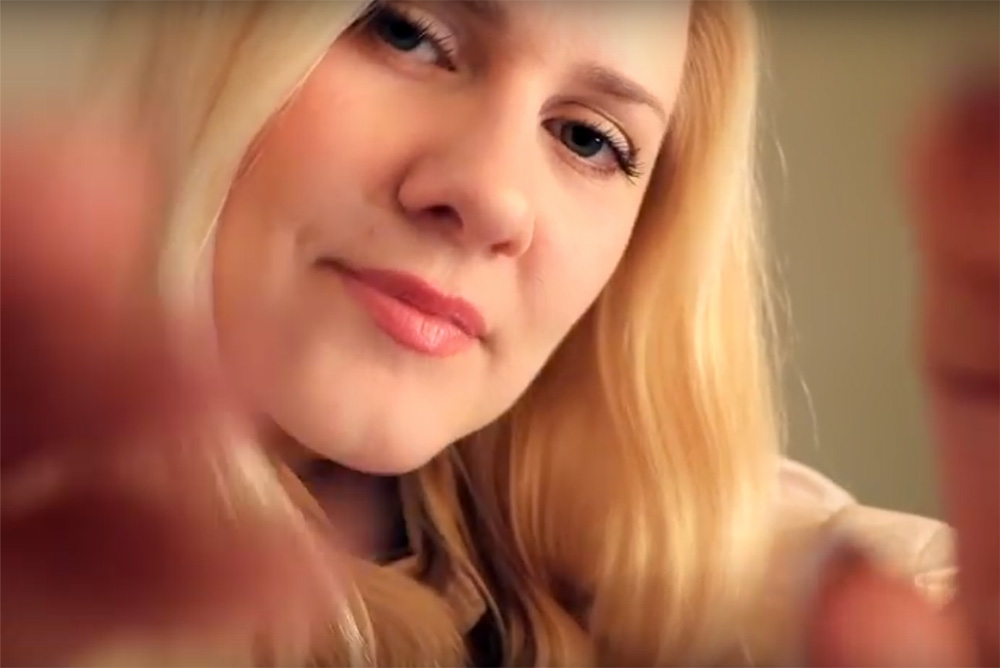
ASMRtist Maria
By Mary Carpenter
THE “EXPLODING” popularity during the pandemic of ASMR (autonomic sensory meridian response)—listening or watching other people whisper, brush their hair, crinkle paper and even clean their ears—has led our well-being editor, Mary Carpenter, to revisit her fall 2018 post. On YouTube, ASMR hovers between the second and third most popular search term both in the U.S. and worldwide.
“It’s no surprise that ASMR exploded in popularity during the pandemic,” said Cleveland Clinic psychologist Susan Albers—because of reduced access to mental health, and because ASMR “helps with sleep, reducing anxiety, and inducing calm.”
Tingling is how ASMR adherents describe the sensation, relaxing but at the same time euphoric—while others feel nothing. And only among those in the adherent group, according to Essex University psychologist Giulia Poerio, have researchers found “simultaneously lowered heart rates and increased skin conductance—a slight sweating that indicates sensory arousal.”
The “heightened sensory sensitivity” of ASMR enthusiasts also makes some enthusiasts prone to misophonia—a negative reaction to sounds, such as sniffling or typing, but also to the whispering that others find so pleasing. Extreme misophonia may resemble obsessive-compulsive disorder, according to recent research, with sufferers’ efforts to avoid possible triggers interfering with their daily functioning.
ASMR may be a kind of auditory-tactile synesthesia—and the skin response, a paresthesia, which involves sensations of tingling and chills. Dividing ASMR triggers into six groups, Sam Parker in The Guardian puts sound at number one, “by far the most popular,” followed by visuals—such as paint being mixed. Eating is its own category: watching and listening to people chew. The next two are crushing (objects like sponges being compressed) and role-playing. Last comes “old-fashioned touch, such as someone “’drawing’ on your back.”
From our fall 2018 post:
The doyenne and maybe most-watched Internet ASMRtist, Maria, started her own YouTube channel GentleWhispering ASMR in 2011. “I try to be nurturing, almost a motherly figure,” Maria told “Follow This.” Tracing ASMR’s popularity to increased stress and insomnia in today’s culture, she says: “Our main concern is a viewer’s sleep.”
“People who have insomnia are in a hyper state of arousal,” Columbia University sleep disorders expert Carl Bazil told the New York Times. Grouping ASMR with other behavioral treatments for insomnia such as progressive relaxation, Bazil suggests ASMR videos might be another way “to shut your brain down.” ASMR has been compared to a sensation called musical frisson, a ripple of chills or goosebumps in response to music—studied by Montreal neuroscientist Robert Zatorre, who found a corresponding increase in the brain’s dopamine activity.
On functional MRIs of 22 relaxed subjects, those who reported experiencing ASMR showed differences in their brain networks compared to typical controls, in studies by University of Winnipeg psychologist Stephen Smith and colleagues.
In the first group, unusual areas of the brain, specifically those related to vision, were activated as part of what’s called the brain’s “default mode network”—structures along the brain’s midline that fluctuate together when people are daydreaming; and during altered states of consciousness, such as psychedelic experiences. In the first group, too, there was more blending of different brain networks compared to the controls.
Personality studies of the two groups found the ASMR group “more open to new experience, also more neurotic with a greater level of emotional instability and less agreeable,” said Smith, noting that “at this point it’s a lot of speculation.”
Of 475 self-reported “tingleheads,” 75% said whispering was an effective trigger; and a “sizeable majority” of these said they watched ASMR videos to help them sleep and cope with stress, according to University of Wales psychologists. Despite the reputation of ASMR videos being used for “braingasms” and “whisper porn,” only about 5% of subjects said they chose ASMRotica with sex as their goal.
An Idiot’s Guide to ASMR published in 2015 and Brain Tingles in 2018 are the work of ASMR guru Craig Richard, professor of biopharmaceutical sciences at Shenandoah University in Virginia. Richard, founder of ASMR University, a clearinghouse website with interviews and blogs related to ASMR, believes the intimate experiences of ASMR may trigger feelings of being loved.
Richard addresses the possible connection of the tinglehead to what is often called the Highly Sensitive Person—individuals in the 15 or 20% of the population who struggle with a range oft atypical sensory sensitivities, called “sensory processing sensitivity” or “sensory integration disorder.”
Many ASMR enthusiasts like the anonymity of viewing or listening to stimuli—characterized as “intimacy without vulnerability” by the creators of the Brooklyn N.Y. Whisperlodge, which offers a “sensory journey of live ASMR.” But to critics, the close-up face shots of these videos create artificial intimacy. Maria (of GentleWhispering) believes that artificial intimacy is not better but “if it helps someone, it helps someone, that’s the bottom line.”
If I have a heightened sensory sensitivity, it is mostly misophonia—unpleasant reactions to knuckle cracking and throat clearing. I maneuver desperately to get a “quiet” car seat on Amtrak. After viewing a few ASMR videos, I can’t imagine getting any benefit from these experiences nor can I imagine finding time for them when I rarely get to my clearly beneficial P.T. exercises.
—Mary Carpenter
Every Tuesday in this space, well-being editor Mary Carpenter fills us in on health news we can use.
